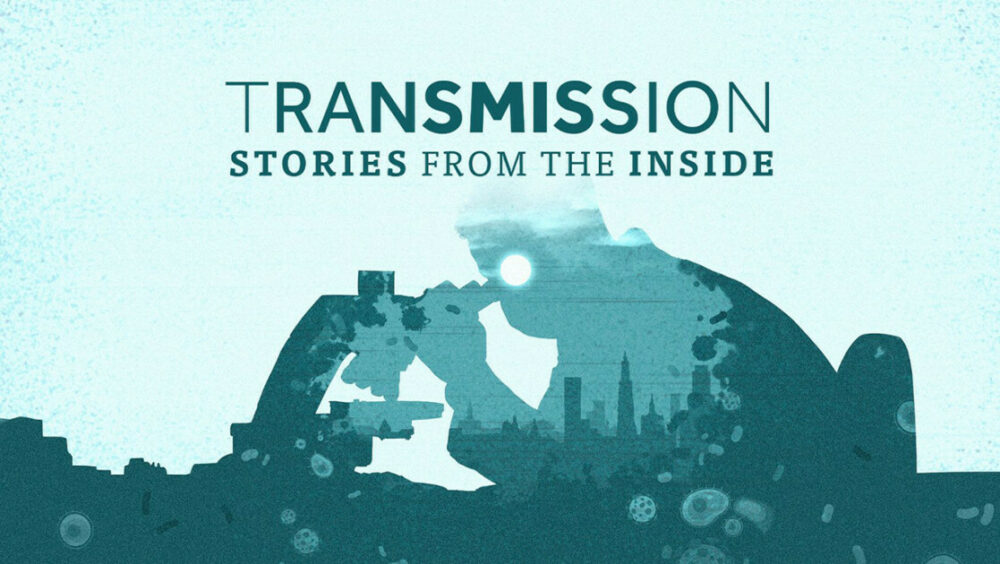Nothing works better than a story: lessons from ‘Transmission’ podcast
How can you convey difficult or complex things to your audience? With a story! We noticed this again when we made the podcast ‘Transmission’ for the Institute of Tropical Medicine.
In that podcast, we explored whether we are ready for the next virus outbreak. Think we’ve had it with viruses after Corona? Forget it! Researchers and doctors tell their personal stories in four episodes, from Antwerp to deep in the Congo rainforest.
What three lessons from making a science podcast can also help you when you want to warm an audience to your research?

1. First the story, then the more abstract message. Not the other way around.
Abstract words only say a little and have a hard time to stick around in the minds of your audience. Only once you make it concrete and your audience can imagine what you’re telling them, the movie starts to play, and they’re on board with your presentation.
For example, in episode 3 of the podcast, we wanted to clarify that working in a foreign environment is challenging. If you start that explanation with a dry description of integrating well into another international culture, you lose the audience from the beginning.
That is why we started with the following story :
Kathy Kreppel, epidemiologist from ITM is setting up her tent with the help of children, a lot of children. She has found the perfect spot: under a beautiful, large mango tree. After a while Kathy and the children have gathered a whole audience.
Kathy: ‘We had kind of this whole audience, the kids putting up my tent, very happy, banging things everywhere. They had no idea how to put it up. They just tried their best.’
But there’s something going on that Kathy couldn’t put her finger on. At the edge of all the activity, the village elders were watching, standing there and shaking their heads. They watched with a look of ‘When is she going to notice.’
But Kathy had no idea what to notice.
Moments later, what Kathy should have noticed became clear: snakes fell from the mango tree onto her tent as the sun set. The village elders had not warned Kathy, assuming that the foreign expert would be smart enough to know what would happen. Nor had she asked for anything.
This story makes it immediately clear how important it is to listen to the local people before you go about your work as a researcher.
If you start your presentation with a story about snakes falling on your tent, you can be sure that the audience will pay attention. If, on the other hand, you start with a dry explanation, only a fraction of your audience will jump on board with you.
Make sure your story logically links to your research. In the story about the snakes, the message is clear: listen to those involved before you start. In fact, there is even a universal message behind it. Telling a story without a link to your research or a clear message quickly feels like a trick.
2. Discover your own stories.
Often, researchers don’t see their stories themselves. You may fall into the trap, too, where you think your research is not interesting enough. That’s not true.
It’s understandable that you don’t always see the stories in your research anymore: you work day and night on a topic and may not find it so exceptional anymore. But for the public, it’s the first time they hear about it. Setbacks, funny anecdotes, strange locations. Share them with the audience!
Maybe you shoot frozen ducks into new aircraft engines to test whether they can withstand a bird impact (yes, some researchers do that), develop ink to 3D print organs, or had to number five hundred Petri dishes for your latest experiment. There are things in there worthy of a story, but you must see them.
Not sure which stories are worthwhile? Then think about the last time you told your friends something about your work. What did you tell them then? Was it an interesting anecdote or a silly incident? Were you dancing in the hallway because your questionnaire produced the right results? Or were you sulking because you had to go to the lab on a Sunday morning to feed your test fish? Everything is a story.
3. Put yourself in the lead role.
Sure, you can tell a story about Patricia the farmer, or Sam the nurse, and that works better than no story. But it works much better if you put yourself in the story.
Putting yourself at the centre is something many researchers find difficult, but when we see you standing on that boat or struggling in the lab, that has the most impact.
During a presentation, you can show a picture of yourself in that cavern or fishing in the North Sea. So remember to regularly ask colleagues to take pictures during your research.
Want to know more?
Nothing works better than a strong story. Want to know how the story of Kathy Kreppel and her colleagues continues? Then listen to Transmission (on Spotify, Apple podcasts or wherever you get podcasts). We are already looking forward to your feedback!
————–
Would you also like a podcast for your organisation, research or project? We would love to help you with it. Contact us at info@thefloorisyours.be.
————–
Credit where credit is due: Toon Verlinden of The Floor is Yours did the interviews, made the selections, wrote the texts and did the editing on paper. The team from Sonhouse took care of the technical side, the beautiful music, final editing and sound effects.